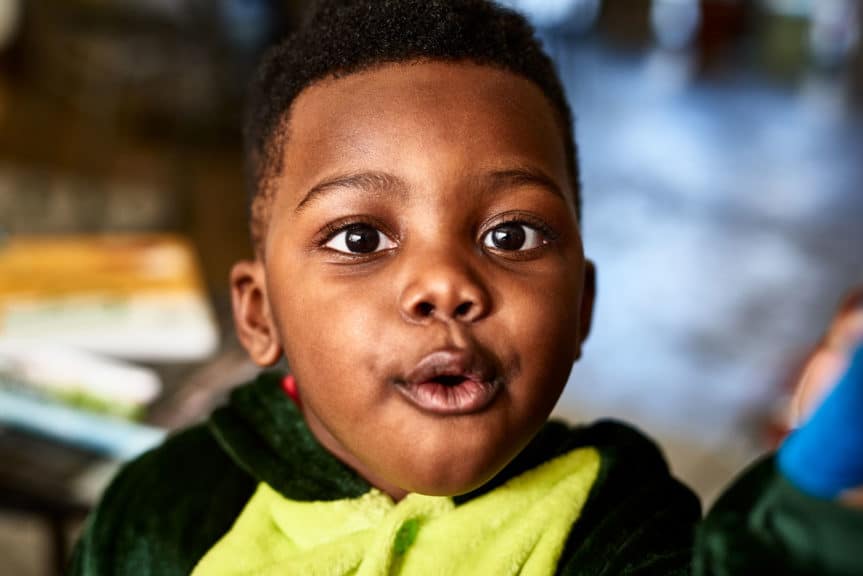Do you remember learning how to pray?
If you were a child of the 70s/80s like me, you may have grown up believing that there was a special set of rules you had to follow if you wanted God to hear you.

I still remember how liberating it felt when I eventually learned—at some point well into my spiritual journey—that I didn’t have to be sitting down with my eyes closed in order for my prayer to “count.”
There was something uncomfortable about those early prayers, with hushed tones, complete stillness, heads bowed, eyes closed, and hands folded.
It seemed a little boring, and I was afraid I might mess up if I sneezed or something!
When I was a little older, I would picture those prayers bouncing off the ceiling and ricocheting back to my chair, unable to escape my roof and make their way to the heavens.
It seemed to make much more sense to pray outside, feeling the breeze in my hair and maybe even twirling a bit. But I don’t remember anyone ever encouraging me to do anything like that.
As grownups, we know that prayer doesn’t have to be ritualistic or formulaic. It isn’t some complicated code we have to know if we want to access God.
It’s simply talking to God—like we talk to our friends, neighbors, parents, and siblings.
Prayer shouldn’t feel intimidating or scary—we don’t have to worry that we might mess up. But do the kids we teach know this? Are we teaching them how they actually learn?
As we teach kids to pray in our churches, here are five key things we should avoid saying or unintentionally communicating.
Prayer Is Only for Adults
Of course, we know that God loves the prayers of children, but do our actions back that up?
We may decide it’s just easier to do the praying ourselves when we look at the clock and think there’s not enough time for nine five-year-olds to pray.
The best way for kids to learn to pray is to actually pray!
Or we may wince at the thought of yet another preschooler asking God to resurrect a beloved pet from the dead, and thus try to avoid that situation.
But the best way for kids to learn to pray is to actually pray! It’s OK for the adults to pray, too, but the kids should have ample opportunities to pray as well.
Allow time for it in your schedule and encourage them that God loves to hear their prayers.
There’s a “Right Way” to Sit When You Pray
A group of squirrely preschoolers confined to a tight classroom may need to sit with their hands folded in their laps for prayer. And encouraging kids to close their eyes may help minimize distractions.

But if your environment allows for it, encourage kids to practice different types of prayer postures.
I still remember how liberating it felt when I eventually learned—at some point well into my spiritual journey—that I didn’t have to be sitting down with my eyes closed in order for my prayer to “count.”
Prayer while sitting (1 Chronicles 17:16), standing (Nehemiah 9:5), kneeling (Luke 22:41), bowing (Nehemiah 8:6), walking (2 Kings 4:35), and standing with uplifted hands (1 Timothy 2:8) are all modeled in the Bible.
Training kids that they don’t have to sit still with their eyes closed—and encouraging them to pray while doing active things like running, swinging, or brushing their teeth—will serve them well throughout their lives because it encourages them to pray regardless of where they are or what they’re doing.
There Are Only Certain Times to Pray
We may inadvertently model that prayer only happens at the beginning or end of church or before meals or snacks.
Mix up your routine. Pray in the middle of your time together. Say a breath prayer, audibly (such as “Teach us your ways, Lord”), as you transition from one activity to another.
Talk about your own prayer life—including all the different times and places you like to pray.
Pray without ceasing
—1 Thessalonians 5:17
Help kids understand the Bible’s command to “pray without ceasing” (1 Thessalonians 5:17). It means that God wants us to talk to Him all day long and that we can do that even at school, in the car, or in the dentist’s chair!
We Should Only Use Certain Words When We Pray
If kids feel like there’s a certain formula for praying, they are a lot less apt to pray. They won’t want to get it wrong. This is especially true when praying in front of other people.
Prayer shouldn’t feel intimidating or scary—we don’t have to worry that we might mess up.
Ending every prayer “in the mighty name of Jesus who is able to do immeasurably more than all we ask or imagine” is a mouthful for a young child.
Even reciting the Lord’s Prayer could be confusing to a kid who has learned to say the word “hallowed” but has no idea what it means.

Offering suggestions for how to pray can be helpful. Be sure to emphasize that there’s not one set of words that we have to use in order for God to hear us. He wants to hear our words, not some secret formula.
Prayer Is How We Get What We Want
This is a tricky one—especially when you’re studying verses like Mark 11:24: “Whatever you ask for in prayer, believe that you have received it, and it will be yours.”
We want to teach kids that prayer isn’t just asking God for things—it’s talking to Him about everything.
This is true in all relationships. Their dads and moms don’t just want to hear what their kids want or think they need; they want to talk about other things too.
Still, the idea of supplication—humbly making our requests to God—is certainly biblical. Our kids should know this is a legitimate aspect of prayer.
When they do want to talk to God about something they want, we can steer them toward verses like 1 John 5:14. Assure kids that we can approach God confidently and that He hears us when we pray.
God may not always answer our prayers the way we’d like. But, we can be sure that He always hears them. He knows what’s best for us, and He’s always working for the good of those who love Him (Romans 8:28).
Praying with Confidence
I am so thankful for those servants of God who taught me how to pray by modeling it for me when I was a child. I also thank God for what He’s taught me about prayer since then.
Today, I know I can pray while I’m walking, running, driving, shopping, cooking, showering, and so on.
My eyes are rarely closed. I can’t even remember the last time I bowed my head and folded my hands.
Sometimes I start with a song of praise. Sometimes I begin my prayers by confessing my sins. A lot of times I just jump right in: “God, please help me!”
I know that God loves it when I draw near to Him and pour out my heart—no matter what it looks like.
Approach God’s throne of grace with confidence, so that [they] may receive mercy and find grace.
—Hebrews 4:16
I’ve always admired kindergarten teachers because they get to do one of the coolest jobs in the world: teach kids to read. They’re helping them learn something that will change their lives.
Those of us in children’s ministry have a pretty cool job too. We get to partner with parents to teach kids to pray and help them hear their callings!
What could be more life-changing than helping them “approach God’s throne of grace with confidence, so that [they] may receive mercy and find grace” in their times of need (Hebrews 4:16)?
Did you enjoy this article? For more ideas on teaching kids how to pray, check out this article!

66 Short Bible Verses Perfect for Kids to Memorize

66 Short Bible Verses Perfect for Kids to Memorize











